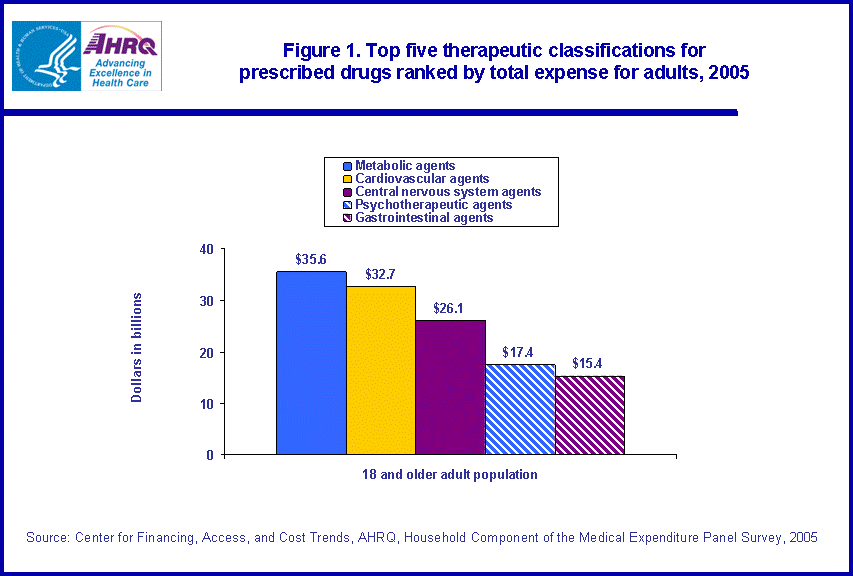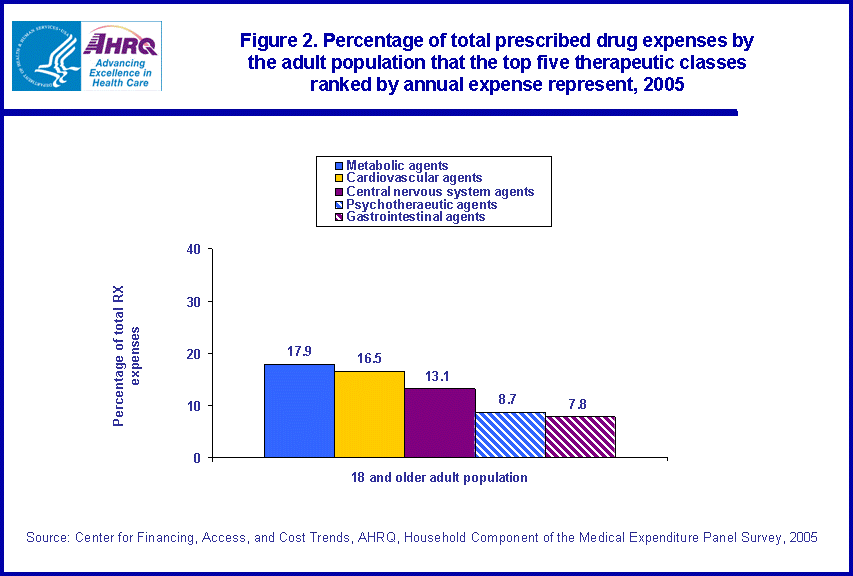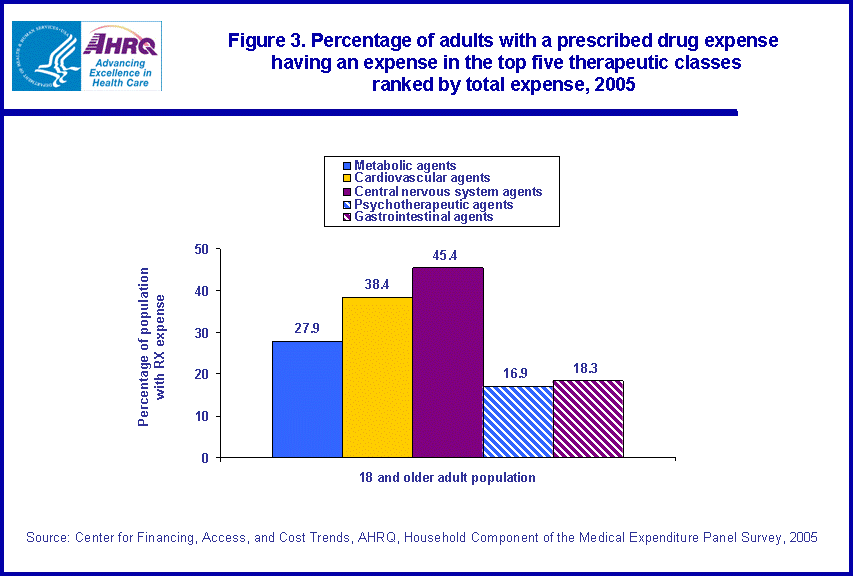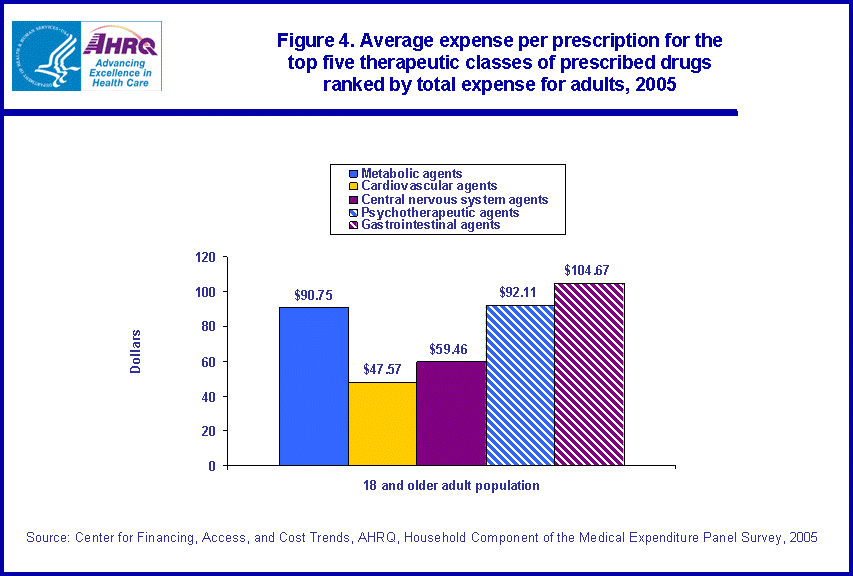
|
|
Font Size:
|
||||
|
|
|
|
||||
STATISTICAL BRIEF #198:
The Top Five Therapeutic Classes of Outpatient Prescription Drugs Ranked by Total Expense for Adults Age 18 and Older in the U.S. Civilian Noninstitutionalized Population, 2005
Highlights
- In 2005, for adults, the top five therapeutic classes when ranked by total expense for prescription drugs were metabolic agents ($35.6 billion), cardiovascular agents ($32.7 billion), central nervous system agents ($26.1 billion), psychotherapeutic agents ($17.4 billion) and gastrointestinal agents ($15.4 billion).
- Expenditures on the top five therapeutic classes when ranked by total expense were $127.2 billion and accounted for nearly two-thirds (63.9 percent) of total expenditures spent on prescription drugs by the adult population ($198.9 billion) in 2005.
- During 2005, metabolic agents prescription medicine expenses accounted for 17.9 percent of total prescription drug expenses by adults.
- Forty five percent of the adult population with a prescribed drug expense in 2005 purchased a central nervous system agent.
- In 2005, of the top five therapeutic classes: gastrointestinal agents had the highest average expense per prescription ($104.67), which was more than double the average expense of the therapeutic class with the lowest average expense, cardiovascular agents ($47.57).
Introduction
This Statistical Brief provides a summary of the top five therapeutic classes of outpatient prescription drugs for adults age 18 and older when ranked by total expense, as reported by households in the U.S. civilian noninstitutionalized population in calendar year 2005. The brief also provides estimates for the population age 18 and older on the percentage of annual prescribed drug expenses the top five therapeutic classes represented, the percentage of those with a prescribed drug expense having an expense in these classes of drugs, and the mean expense in these classes of drugs.
The estimates in this brief are derived from the Household Component of the 2005 Medical Expenditure Panel Survey (MEPS-HC). Only prescribed medicines purchases in an outpatient setting are included in the estimates. Insulin and diabetic supplies and equipment are included in MEPS prescribed medicines estimates. Over-the-counter medicines are excluded from these estimates as are prescription medicines administered in an inpatient setting, clinic, or physician's office. All differences discussed in the text are statistically significant at the 0.05 level.
Findings
In 2005, the top five therapeutic classes for prescribed drugs purchased by adults age 18 and older when ranked by total expense totaled $127.2 billion and accounted for 63.9 percent of the $198.9 billion total prescription drug expenses by adults (estimates not shown). Metabolic agents ranked first in terms of total expenses at $35.6 billion, closely followed by cardiovascular agents at $32.7 billion. Central nervous system agents ($26.1 billion), psychotherapeutic agents ($17.4 billion), and gastrointestinal agents (15.4 billion) were the remaining three top therapeutic classes in terms of expenditures (figure 1).
In 2005, annual expenses for metabolic agents and cardiovascular agents were the two highest of the total prescription drug expenses by the adult population. Expenditures on these two accounted for 17.9 percent and 16.5 percent, respectively. Central nervous system agents represented 13.1 percent of total prescribed drugs purchased by adults in 2005, which was higher than psychotherapeutic agents (8.7 percent) and gastrointestinal agents (7.8 percent) (figure 2).
In 2005, for adults with a prescribed drug expense, central nervous system agents had the highest percentage of adults purchasing at least one (45.4 percent) as compared to the other four categories in the top five therapeutic classes of prescription drugs when ranked by total expense. The percentage of adults purchasing a cardiovascular agent (38.4 percent) and the percentage of adults purchasing a metabolic agent (27.9 percent) were higher than the percentage of adults purchasing gastrointestinal agents (18.3 percent) and psychotherapeutic agents (16.9 percent) (figure 3).
Of the top five therapeutic classes when ranked by total expense for adults in 2005, gastrointestinal agents had a mean expense per prescription of more than $100 ($104.67), which was higher than the average expense for the remaining four classes in the top five: psychotherapeutic agents ($92.11), metabolic agents ($90.75), central nervous system agents ($59.46) and cardiovascular agents ($47.57) (figure 4).
Data Source
The estimates in this Statistical Brief were derived from the MEPS 2005 Prescribed Medicines file (HC-094A).
Definitions
Therapeutic classes were assigned to drugs using Multum Lexicon variables from Cerner Multum, Inc. Please note, the therapeutic class of central nervous system agents includes the large subclass of analgesics; and the therapeutic class of psychotherapeutic agents includes the large subclass of antidepressants.
For the 2005 data, Cerner Multum made changes to the Multum Lexicon therapeutic classification system. As an example, antihyperlipidemic agents, which had been its own therapeutic class in the 2003 and 2004 data, were reclassified as a therapeutic subclass of the new therapeutic class, metabolic agents. Changes to the Multum Lexicon therapeutic classification system should be kept in mind when comparing therapeutic class rankings from year to year.
For additional information on these and other Multum Lexicon variables, as well as the Multum Lexicon database itself, refer to the following Web site: http://www.multum.com/Lexicon.htm.
About MEPS-HC
MEPS-HC is a nationally representative longitudinal survey that collects detailed information on health care utilization and expenditures, health insurance, and health status, as well as a wide variety of social, demographic, and economic characteristics for the civilian noninstitutionalized population. It is cosponsored by the Agency for Healthcare Research and Quality and the National Center for Health Statistics.
For more information about MEPS, call the MEPS information coordinator at AHRQ (301-427-1656) or visit the MEPS Web site at http://www.meps.ahrq.gov/.
References
For a detailed description of the MEPS-HC survey and sample design, and methods used to minimize sources on nonsampling error, see the following publications:
Cohen J. Design and Methods of the Medical Expenditure Panel Survey Household Component. MEPS Methodology Report No. 1. AHCPR Pub. No. 97-0026. Rockville, MD: Agency for Healthcare Policy and Research, 1997. http://www.meps.ahrq.gov/mepsweb/data_files/publications/mr1/mr1.shtml
Cohen S. Sample Design of the 1996 Medical Expenditure Panel Survey Household Component. MEPS Methodology Report No. 2. AHCPR Pub. No. 97-0027. Rockville, MD: Agency for Healthcare Policy and Research, 1997. http://www.meps.ahrq.gov/mepsweb/data_files/publications/mr2/mr2.shtml
Cohen, S. Design Strategies and Innovations in the Medical Expenditure Panel Survey. Medical Care, July 2003: 41(7) Supplement: III-5-III-12.
Suggested Citation
Soni, A. The Top Five Therapeutic Classes of Outpatient Prescription Drugs Ranked by Total Expense for Adults Age 18 and Older in the U.S. Civilian Noninstitutionalized Population, 2005. Statistical Brief #198. January 2008. Agency for Healthcare Research and Quality, Rockville, MD. http://www.meps.ahrq.gov/mepsweb/data_files/publications/st198/stat198.shtml
AHRQ welcomes questions and comments from readers of this publication who are interested in obtaining more information about access, cost, use, financing, and quality of health care in the United States. We also invite you to tell us how you are using this Statistical Brief and other MEPS data and tools and to share suggestions on how MEPS products might be enhanced to further meet your needs. Please e-mail us at mepspd@ahrq.gov or send a letter to the address below:
Steven B. Cohen, PhD, Director
Center for Financing, Access, and Cost Trends
Agency for Healthcare Research and Quality
540 Gaither Road
Rockville, MD 20850
 |
||||||||||||||||
|
||||||||||||||||
|
|
||||||||||||||||
 |
||||||||||||||||
|
||||||||||||||||
|
|
||||||||||||||||
 |
||||||||||||||||
|
||||||||||||||||
|
|
||||||||||||||||
 |
||||||||||||||||
|
||||||||||||||||
|
|
||||||||||||||||


